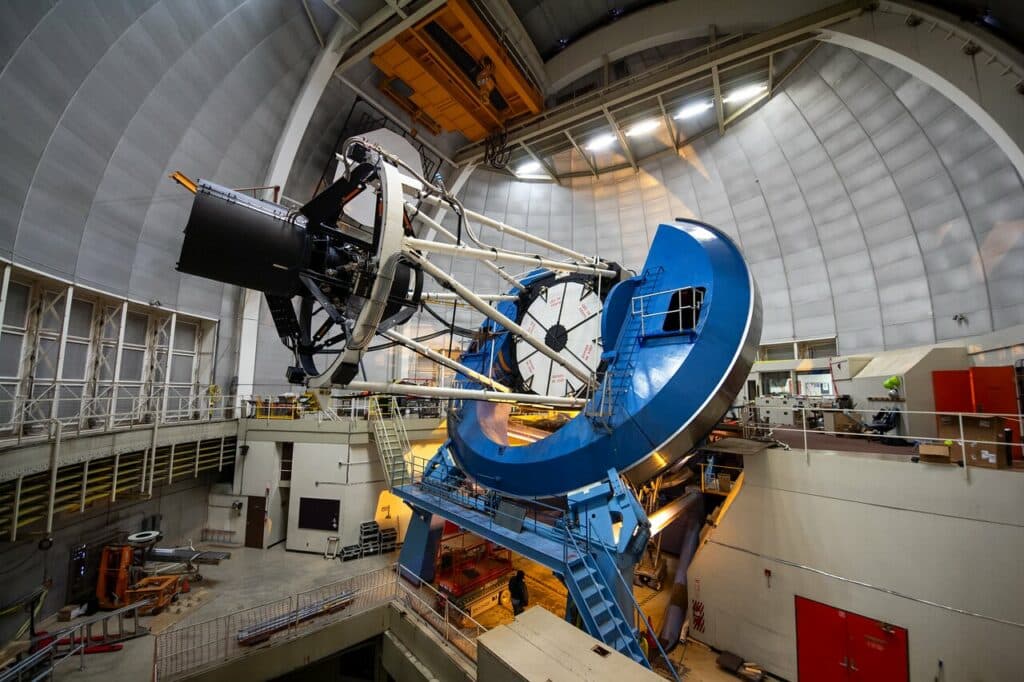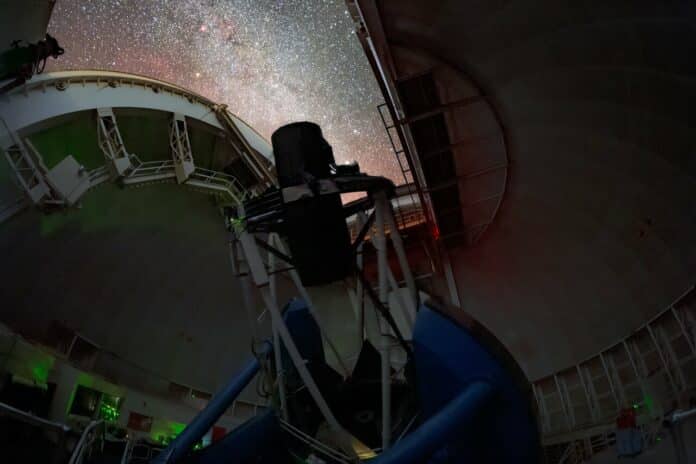Nearly two million objects, including distant galaxies, quasars, and stars, comprise the early data release from the Lawrence Berkeley National Laboratory Dark Energy Spectroscopic Instrument (DESI) at Kitt Peak National Observatory, a Program of NSF’s NOIRLab. These data will help researchers study the expansion history of the Universe in unprecedented detail and explore other frontier areas of astrophysical research. DESI is funded by the US Department of Energy and managed by Berkeley Lab.
The observable Universe is imponderably vast, and it’s getting bigger faster. To study dark energy, the mysterious force behind the accelerating expansion of our Universe, scientists are using the Lawrence Berkeley National Laboratory (Berkeley Lab) Dark Energy Spectroscopic Instrument (DESI) — installed at Kitt Peak National Observatory, which is a Program of NSF’s NOIRLab — to measure light from more than 40 million galaxies, quasars, and stars. That light tells researchers how far away an object is, building a 3D cosmic map. DESI is funded by the US Department of Energy (DOE) and managed by Berkeley Lab.

Today, the collaboration publicly released its first cache of data, with nearly two million objects for researchers to explore. The monumental dataset comes from 2480 exposures taken over six months during the experiment’s ‘survey validation’ phase in 2020 and 2021 — the period between turning the instrument on and beginning the official science run.
“The fact that DESI works so well, and that the amount of science-grade data it took during survey validation is comparable to previous completed sky surveys, is a monumental achievement,” said Nathalie Palanque-Delabrouille, co-spokesperson for DESI and a scientist at the Department of Energy’s Berkeley Lab, which manages the experiment. “This milestone shows that DESI is a unique spectroscopic factory whose data will not only allow the study of dark energy but will also be coveted by the whole scientific community to address other topics, such as dark matter, gravitational lensing, and galactic morphology.”
The DESI early data release is available as catalogs and spectral (splitting an object’s light into different colors) files from the National Energy Research Scientific Computing Center, the supercomputer that processes DESI’s data. In addition, a portion of the DESI early data release is available as searchable databases via the Astro Data Lab at the Community Science and Data Center, a Program of NOIRLab, and the new SPectral Analysis and Retrievable Catalog Lab (SPARCL).
“SPARCL is rather innovative as a flexible database of spectra, whereas databases more commonly serve tables and catalogs,” said Stephanie Juneau, an astronomer with NOIRLab, and Astro Data Lab’s spectroscopic science lead. “It’s not the first spectral database, though it is the first to serve DESI spectra. This capability offers several advantages in performance and convenience compared to users having to download and open numerous files to obtain the DESI spectra they are interested in using.”
Today the DESI collaboration also published a set of papers related to the early data release, which includes early measurements of galaxy clustering, studies of rare objects, and descriptions of the instrument and survey operations. The new papers build on DESI’s first measurement of the cosmological distance scale that was published in April, which used the first two months of routine survey data (not included in the early data release) and also showed DESI’s ability to accomplish its design goals.
As the Universe expands, it stretches the wavelengths of light, making it redder — a characteristic known as redshift. The further away a galaxy is, the bigger its redshift. DESI, which is the world’s most powerful multi-object survey spectrograph, specializes in collecting redshifts that can then be used to solve some of the biggest puzzles in astrophysics: what dark energy is and how it has changed throughout the Universe’s history.
“There are some well-trodden spots where we’ve drilled down into the sky,” said Stephen Bailey, a scientist at Berkeley Lab who leads data management for DESI. “We’ve taken valuable spectra in areas that are of interest to the rest of the community, and we’re hoping that other people will take these data and do additional science with them.”
Two interesting findings have already surfaced: evidence of a mass migration of stars into the Andromeda Galaxy, and incredibly distant quasars, the extremely bright and active supermassive black holes found at the centers of galaxies.
“We observed some areas at very high depth. People have looked at those data and discovered very high redshift quasars, which are still so rare that basically any discovery of them is useful,” said Anthony Kremin, a postdoctoral researcher at Berkeley Lab who led the data processing for the early data release. “Those high redshift quasars are usually found with very large telescopes, so the fact that DESI — a smaller, 4-meter survey instrument — could compete with those larger, dedicated observatories was an achievement we are pretty proud of and demonstrates the exceptional throughput of the instrument.”
Survey validation was also a chance to test the process of transforming raw data from DESI’s ten spectrometers into useful information.
“The DESI project is a fabulous example of how two agencies, NSF and the Department of Energy, can come together to maximize scientific return for an established telescope,” said Chris Davis, NSF Program Director for NOIRLab. “We look forward to many years of spectacular discoveries by the survey team, and by the broader US scientific community as more data from DESI are made publicly available.”
There are plenty of data yet to come from the experiment. DESI is currently two years into its five-year run and ahead of schedule on its quest to collect more than 40 million redshifts. The survey has already cataloged more than 26 million astronomical objects in its science run, and is adding more than a million per month.
